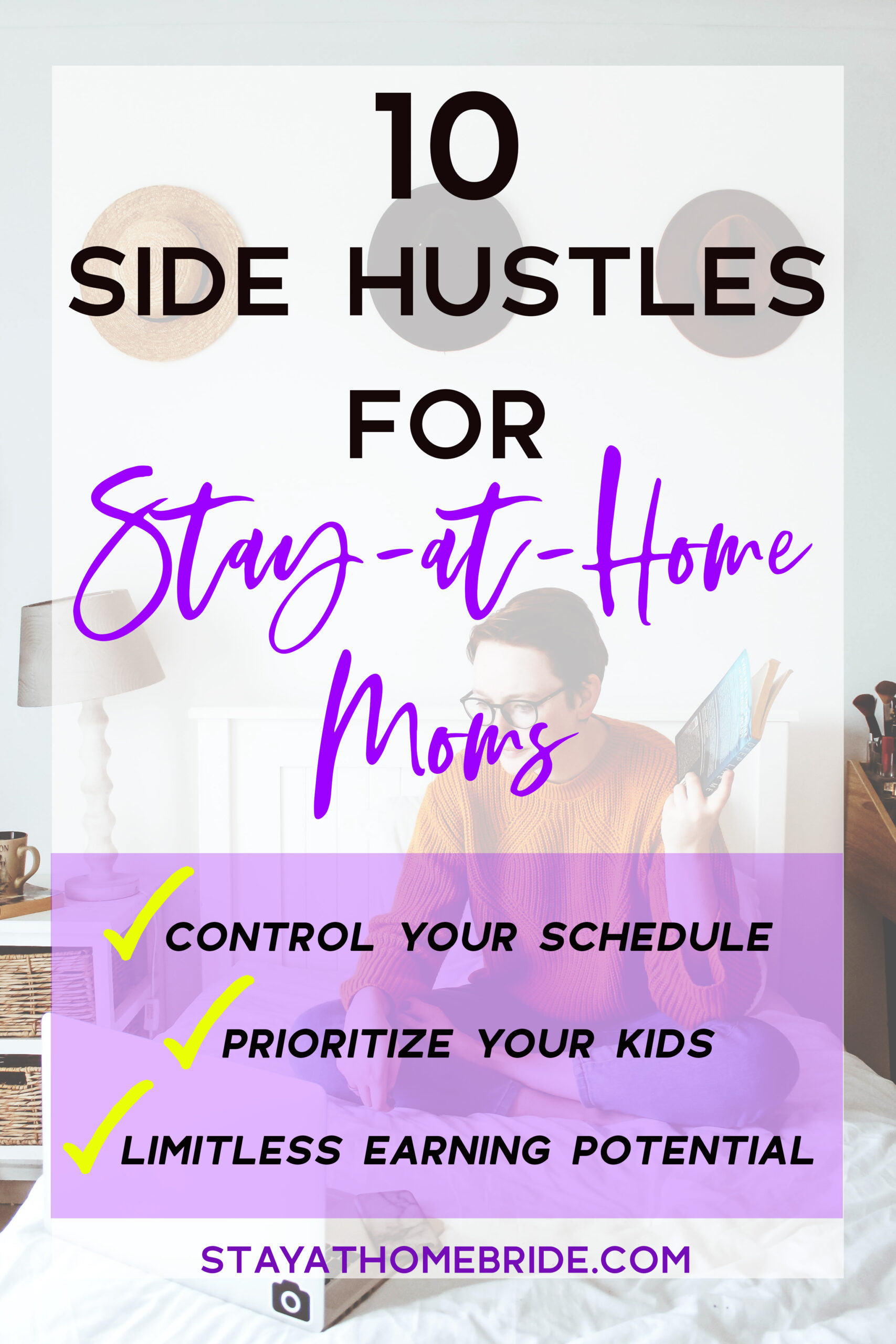When you’re just starting out in the search for self-employed, stay-at-home-mom jobs, it’s overwhelming.
Which jobs are legit?
Will you get scammed?
Can you actually earn a living? Sure, knitting sweaters for Etsy sounds fun and all…but can it really land a profit?
Then there’s a host of MLM organizations, in which you hustle endlessly for little to no return (and end up with tons of product sitting in your garage for years afterward).
Survey sites promise big paychecks, but pay literal pennies for hours of work.
And what if you just have no idea what stay-at-home jobs interest you, or how to get started doing one?
Why I Chose to be a Work-at-Home Mom
When my first child was born, I struggled with my sense of identity. All I did anymore, it seemed, was clean the house, cook meals, clean some more, and care for the baby.
While I wouldn’t trade motherhood for anything, I knew something was missing. And when I started working for myself, I got that “something” back.
My stay-at-home mom jobs include indie author, blogger, and freelance writer. It’s insanely challenging juggling three related but different jobs with motherhood, but I adore it.
I love being my own boss, and I want every single mom out there who feels the way I felt—like a piece of them is missing—to have the chance to get that back.
Here are 43 great stay-at-home mom jobs, without a survey or MLM in sight. You’ll also learn exactly how to get started, where to find work, and what you can expect in terms of income.
This post may contain affiliate links. Read the full disclosure here.
43 Stay-at-Home Mom Jobs
Stay-at-home moms need career options with two things: flexibility of hours, and the ability to either work from home, or bring their kids along. These 43 stay-at-home mom jobs provide exactly that.
Jump to:
- Audiobook narrator
- Junk flipper
- Freelance writer, editor, or photographer
- Professional baker or cake decorator
- Etsy shop owner
- Transcriptionist
- Translator
- Online tutoring
- Making T-shirts
- Hair Stylist, Makeup Artist, or Nail Artist
- Laundry Service
- Professional organizer
- Candle or soap making
- Tax Preparation
- Daycare Operator
- Adult Caregiver Relief
- Dress Alterations
- Sell Home-Grown Produce, Pies, or Preserves
- Landlord or Airbnb Host
- Blogger or Vlogger
- Illustrator
- Interior Decorator
- Indie Author
- Dropship Store Owner
- Digital Goods Seller
- Website/Graphic Designer
- Yoga Instructor
- Florist
- Venue Provider
- Stock Musician
- Piano (or Any Instrument) Teacher
- Tea Maker
- Investor
- Massage Therapist
- Virtual Assistant
- Electronics or Furniture Repair
- Gift Wrapping
- Consultant
- Pet Groomer, Trainer, or Boarding Service
- Shopper/Errand Service
1. Audiobook Narrator
I thought it’d be fun to start with a suggestion you might not have heard of, yet—at least not as viable career for self-employed moms.
Narrating audiobooks can be done in the privacy of your own home. It also requires minimal experience to start landing interesting, fun, and lucrative gigs.
One caveat: you’re paid by the finished audio hour, not hours worked.
The money can still be excellent, especially as your skills improve, because it will take you less time to produce each hour of content.

How can you get started as an audiobook narrator?
First, study the craft.
You might have a lovely reading voice with great pacing. You might even have a background in acting.
But narrating books is still a little different than reading aloud or performing a script.
You often have to differentiate character voices during dialogue, including other genders, ages, or even species!
And you have to do that without sounding downright cheesy. A lowered, husky voice for male speakers is easy to do as a woman, but you need to perfect yours: make it sound like you’re imitating, but not mocking.
Once you’ve gotten some practice, create a sound booth to record yourself in. Some narrators have elaborate equipment and professional booths, but when you’re just starting out, making do with budget-friendly options is fine.
All you’ll really need is a good microphone and some egg crate foam, your laptop, and a printer (if you want to read the text off something besides a tablet and make notes, which is highly recommended). When you get more work, you can upgrade your setup.
Where do you find work narrating audiobooks?
Freelancing is one option; you can build a simple website with samples—eventually adding in excerpts from your portfolio, as you land more gigs—and a contact form where possible clients can get in touch.
Another option is Fiverr, a freelancing website where you set a fixed rate for basic services in your field. You can also include add-ons (like dual POV narration, if the book switches main characters frequently) for extra fees.
The top recommendation, though, is ACX.
On ACX, the work is already put in front of you. You get to choose which books to audition for. Publishers and indie authors can contact you directly, as well.
Some projects are offered at a finished-hour rate, while others are paid by royalty-share: for every copy sold once the book is completed, you get a percentage of that money. Not great if the book happens to tank…but very lucrative if it does well.
It’s also a nice setup for passive income that will keep trickling in years down the line. Not many other stay-at-home jobs out there can keep earning you money, even while you sleep.
One more thing: if you’ve got noisy kids or can’t work at night, this might not be your preferred pick of stay-at-home mom jobs. On the other hand, those quiet hours during naps or weekends can add up. Turn that closet into a sound booth and try it out!
How much can you earn as an audiobook narrator?
The U.S. Bureau of Labor Statistics categorizes audiobook narrators as actors, which earn an average of about $20 an hour.
Since most narrators charge $100 to $300 per finished audio hour, and it takes, on average about 6.2 hours working hours to complete that finished hour, your hourly wage can vary quite a bit—from $10 to $50 or more, when all is said and done.
Keep in mind that, the more experience you get, the more you can charge…and the fewer hours you’ll need to complete finished audio hours. Both those factors will significantly increase your hourly rate.

2. Junk Flipper
Okay: I don’t really expect moms to go flip “junk.” Actual garbage is best left in the garbage.
But there is plenty of money to be had rescuing, refurbishing, and reselling old or discarded items others have given up on, including clothes or furniture.
How can you get started flipping junk?
Before you get started, you need inventory.
Flea markets, thrift stores, estate sales, clearance racks: you can stock your digital shelves easily, and with everything from high-end clothing to rare toys.
If you’ve got enough space to store it, furniture off Facebook Marketplace can also turn a nice profit.
What’s more, you don’t even need to alter the object. “Flipping” can mean cleaning something up or improving it, but it really just means selling anything for more than you bought it.
Depending on how large you want your business to get, you can choose to focus on a specific niche, or start as a part-time, catch-all kind of seller, flipping anything interesting you come across.
If you’ve got knowledge in a particular area, use it! Fashion-savvy moms will have way more fun (and less stress) shopping for and selling items they know well, like designer jackets. History buffs might enjoy flipping rare glassware or pottery.
And if shopping is more your style, scooping up great clearance deals from Target end caps or Big Lots bins will feel very natural (and thrilling).
Where do junk flippers sell their finds?
I’m a fan of eBay, myself. It’s great for random or hyper-specific items, and sometimes buyers get into bidding wars to drive your auction price up.
You can also just list it for sale without an auction, though, and let buyers make offers you can accept or reject. Some sellers strongly prefer this method, because it cuts out the fuss. I use a combination of both, depending on the item.
Amazon’s FBA (fulfillment by Amazon) program is fantastic, as well, if you have a lot of one kind of item. Clearance flippers will do best with this route.
The cool thing about this is, you don’t have to store or ship orders yourself. Simply mail all your inventory to Amazon, and they store it in their warehouse, then ship it when an order comes in—and give you a cut from the sale.
Etsy, Craigslist, Facebook Marketplace, Poshmark: whatever you’re selling, there’s an ideal market to list it on. Do your research on each to decide which will best fit your items and lifestyle.
How much can you make as a flipper?
According to anecdotal reports from places like the flipping subreddit, you can earn thousands a month; some people have even managed to hit six-figure incomes from flipping.
It depends on your niche, more than anything. If you specialize in rare or big-ticket items, you can easily earn a living selling just a few pieces each month.
Items like clothes, on the other hand, will bring less ROI—but they also require less upfront investment to source, and cost less to store and ship.
Like most stay-at-home mom jobs, how much time you can devote to it will also play a role. But even a few hours a week can bring home some good money.

3. Freelance Writer, Editor, or Photographer
I’ve mentioned many times on this blog that freelance writing was my first foray into self-employment, so I’d be remiss to exclude it!
In fact, most of the stay-at-home mom jobs out there are, technically, freelance-based. This is what grants certain positions that flexibility we moms sorely need.
But writing isn’t the only job you can do as a freelancer. Actually, you can freelance almost any service.
Freelancing just means you’re hired by the project, or for a specific time frame, and you or your client can choose to end the working relationship when that project or time ends. You’re not hired into a company; you’re paid by a company or individual to complete something specific.
Editing and proofreading is another lucrative freelance job, as is photography. Some freelancers find success doing all three—like writing a cookbook, editing it, and taking photos of the food for a client.
How can you get started freelancing?
First, focus on the area you’re most interested in.
Second, think about your life as a stay-at-home mom, and jobs that would fit into that schedule.
For example, if photography sounds fun, but you’re not sure you’d have time for weddings every weekend, maybe newborn portraits are a better fit. Think about it: most new moms are home every day, and might love making weekday appointments.
After you’ve decided what kind of freelancer you want to be, you’ll need a website.
It’s a headache if you’re not too tech-savvy, but it doesn’t have to be. A simple Facebook Business page will more than suffice, for now.
You can also set up a profile on Fiverr, Upwork, or similar platforms.
No matter what your website entails, start with the basics: a bio, contact info, and a few portfolio pieces will help you land those first clients.
Also, don’t assume that portfolio pieces have to come from prior work. You can make your own pieces: write some example blog posts, take portraits of your kids…anything to showcase your skills.
Where do you find work as a freelancer?
Content sites like Upwork or Fiverr get a bad reputation, sometimes. You’ll often see writers complain that clients only want the cheapest freelancers, not the best.
While this is sometimes the case, there are plenty of clients on there who actually care about quality, and will pay well to get it. You just have to hunt a little bit.
I got my start on Upwork years ago when it was still called Elance, and I loved it. I could apply to whatever jobs I wanted, and clients could leave reviews after a project was done.
The website did take a fee before I got paid, though, so I eventually left the platform once I was confident in my ability to find my own clients.
I even took some with me! Once you’ve worked with a client on Upwork for 2 years, they’re yours. You can leave the platform and work outside of it, getting paid via PayPal or however you want, with no fees to someone else.
(Note: this is based on the Terms of Service from Upwork at the time of writing. Always check to see if that timeline has changed before taking clients with you.)
For photographers, in particular, word of mouth will be invaluable in landing new work.
Give clients extra business cards to pass out to friends and family; showcase your work on Instagram and Facebook.
Lastly, don’t be afraid to get specific. It’s tempting to go broad when you’re new, but that can leave you drowning in opportunity…or burning out, before you’ve made a dime.
No time to shoot portraits? Consider product photography.
Lousy at writing, but great at spotting typos? Niche down to proofreading: the final edit before a manuscript goes to publication.
How much can you earn as a freelancer?
This is entirely dependent on your industry and how many hours you can work.
According to Indeed, freelance writers can earn $44,850 annually, on average. Editing can bring in $59,396 annually, depending on the kind of edits you do and your experience.
An hourly wage of about $35 is reported for freelance photographers, which extrapolates to about $70,000 a year for full-time work (though some photographers earn the same or more for less hours).

4. Housekeeper
If you love cleaning (and some people really, really do), consider starting your own cleaning service.
You can bring your children with you—assuming you tell clients about this beforehand, and they’re all right with it—and have them play in a safe spot while you work, like a playpen.
How can you get started as a housekeeper?
Like most of the stay-at-home jobs on this list, you won’t need much to get started.
You don’t even have to enjoy cleaning, honestly: just tolerate it enough to do it well!
As for supplies, you might want to invest in a few basics, such as:
- Gloves (multiple sets, for different rooms)
- Microfiber cloths
- Cotton cloths
- Buckets
- Mop
- Broom and vacuum
- All-purpose cleaners, disinfectant sprays, or window cleaners
- White vinegar
- Baking soda
- Bulk paper towels
- Toilet brush
It’s helpful to ask clients ahead of time what supplies and equipment, if any, they’ll provide. Some might prefer you using their products, while others will want you to use your own.
Also, take note of the client’s specifications. If they want you using green or eco-friendly products, that heavy-duty oven cleaner is not going to go over well.
Once you’ve stocked up on all the housekeeping essentials, it’s time to find a few clients.
Unlike freelance writing or photography, your clients have a very high probability of becoming repeat clients. This means hustling for work won’t be a constant chore: if a client likes you and your work, they’ll have you back on a regular basis.
But where on earth can you find those clients?
Where can you find work as a housekeeper?
At the time of writing, care.com allows housekeepers to bring their own child to work if the client specifies that in their job listing.
While the site does take a cut of your pay, I’m a big fan of using platforms like these. They simplify everything so much, which is invaluable if you don’t have many hours to work per week.
Who wants to mess with finding clients or sending invoices, when they’ve only got a few hours each day to spare?
There’s also an added element of safety, and a much lower risk of getting stiffed on a job.
All that said, I’m also a fan of being totally self-employed.
As frustrating as it is to wear every hat in your business (I hate making expense reports!), it’s incredibly freeing. You answer to no one but yourself.
Of course, you’re also an island. And when you’re a stay-at-home mom, you already feel like that enough as it is.
Whether you decide to work through a platform like care.com, or start your own business from the ground up (or some of each!), remember that you still call most of the shots.
You get to choose when and where you work, or to only take clients who allow your kids as tagalongs.
The same goes for what services you provide. If light, weekly cleaning is more your thing, advertise that to potential clients. If you’re more into deep-cleaning once a month or season—which is harder, but lets you charge more, too—put that on your business cards.
Additionally, you decide how many clients you take on.
Does one a week feel like enough for now? Don’t sweat it.
You can always increase that when your kiddos start school, should you decide it’s time to take that SAHM side hustle and crank it into a full-fledged business.
How much can you earn cleaning houses?
According to Indeed, house cleaners earn an average annual salary of $32,408.

5. Professional Baker or Cake Decorator
If you love decorating cakes or making flooded icing cookies, good news: your services are in-demand all year long!
Between holidays, birthdays, graduations, and bridal showers, there’s always something to celebrate—and lots of people want custom-order treats to go with their celebration.
How do you get started as a professional baker?
Ideally, you already have experience in this area (although if you don’t, you can certainly learn).
First and foremost, evaluate your skills as objectively as possible. If there’s any weak spots, brainstorm ways to improve them before launching your business.
For example: if you’re a beast at cake flavors, but no so great with the frosting bag, a decorating class is a worthwhile investment.
Great at frosting, but no idea how to use fondant? Check out some YouTube tutorials until you’ve got that skill down pat.
When your skills are sharp, it’s time to gather your portfolio pieces, just like you would as a freelance writer or photographer. Whip up a few practice cakes or cookies, or take high-quality photos of the cakes you provide to friends and family over the next few months.
This is when it’s tempting to go all-in and buy a bunch of supplies, but keep things simple. Pans, frosting tips, and a few other odds and ends are plenty when you’re starting out, like this Taiker cake decorating set.
A few business cards and bakery boxes might also be good, but order sparingly. You don’t want to invest too much capital in the growth stage of your business.
This is especially true if you plan on staying part-time for a while, like most stay-at-home mom jobs.
How do you find clients as a self-employed baker?
Set up a very simple website or Facebook business page. An Instagram business account is great, too.
Include all those excellent photos of your past creations, even if all you’ve done so far are treats for family members or friends. Write some fun captions that describe what you made, the kind of event it was for, and the flavors or techniques involved.
You can also post videos of yourself working. Some free video editors (I love InShot, personally) let you speed up and splice videos or pictures, add text or music, and even narrate over your videos.
With some practice, you can make some pretty slick looking compilations of yourself icing cookies or cakes. Who knows—you might even go viral!
Next, set your prices. Don’t just factor in supply costs. Consider the time of your labor, delivery costs, setup fees, and your skills’ value.
As for finding clients, get the word out that you’re now baking cakes or cookies: tell friends and family, announce it via your personal Facebook profile, or put up flyers at church.
If you feel particularly daring, you can even experiment with Facebook ads targeted to your town . A quick hint: target women, as they’re more likely to purchase than men.
Be wary, though, as advertising can cost a lot before you get it right. Stay-at-home mom jobs should make money, not burn it (hence, you won’t find a single MLM on this list).
However you land clients, use the ones you do get wisely: ask if they’d mind displaying your business cards near the cake at their event, so the party guests can take one. Baking is, like photography, pretty reliant on word of mouth.
How much can you make as a baker or decorator?
Most professional bakers earn between $28,000 and $38,000 a year, according to Salary.com. This data seems to come from professionals employed by companies, rather than running their own business.
Another source tracking the averages of small bakeries gives an estimated annual salary between $18,000 to $57,000, which seems more in line with similar self-employement ventures and stay-at-home mom jobs of this nature: the more you can work, the more you’ll make.

6. Etsy Shop Owner
If you make something, or even partially make it—like staining an old rocking chair you found on the side of the road—you can sell it on Etsy. Certain antiques and rare items are also allowed for sale.
Knitted or crocheted gifts, homemade jewelry, vinyl printing (like with a Cricut, for example), artwork, handcrafted clothing…if you can make it, you can sell it!
How do you get started opening an Etsy shop?
First, decide what you want to sell.
Then…decide what else you want to sell.
Here’s the first snag you’ll run into as an Etsy seller: empty shops do not move product.
Unlike freelancing, this is not an area where “stay niche” works well. Yes, you want to focus on a particular area, but you definitely don’t want just one particular product. Shoppers will be more apt to buy if they see rows of items for sale, instead of just one or two.
You don’t have to complicate things for yourself, though. If you plan on selling knitted hats, consider separate listings for men, women, and children’s styles. Add a striped variation. Add a few matching scarves or gloves.
Next, you need to open an Etsy account, then click “Start Selling.” The site will walk you through the basics of setting your language preferences, payment methods, and shop name.
After that, you’ll need a shop logo and some photos of your pieces for listings.
You can outsource these tasks via sites like Fiverr, or ask a friend to help.
If you decide to DIY both, keep things simple: take well-lit photos of your products on plain backgrounds, and make your listings descriptive but straightforward.
As for shop logos and branding, check out creativemarket.com for premade templates. Just make sure the files you buy are compatible with the photo editing program you want to use, such as Canva.
How do you make money as an Etsy seller?
Tough love time.
Some Etsy store owners earn full-time wages from their sales.
Others—most, in fact—earn little to nothing.
This isn’t to discourage you, but simply to point out that, of all the stay-at-home mom jobs out there, this one really comes down to how much you love it.
It’s not like housekeeping, where you can slog through and still earn a paycheck: there will be days when sales are abysmal, and your genuine love for creating is all that’s gonna pull you through.
And really, it’s not even a matter of sales, so much as an issue of visibility, or pricing too low.
Most hand-crafted goods take forever to make. A knitted sweater is about 20 hours of work. If you price it at $50 (you shouldn’t, by the way), that’s a paltry $2.50 an hour you’ve earned. And that doesn’t even in factor in the cost of supplies.
If you want your Etsy business to be profitable, first things first: set your prices right.
How do you get visibility as an Etsy shop owner?
Etsy is an absolute sea of sellers, and your little shop is but one boat floating among thousands. Getting noticed might feel like a crapshoot, but there are some ways to get noticed.
Word of mouth is good, but so are Instagram and Pinterest. Post your listings there regularly, or consider hiring models (a few photogenic friends will do, too) to take some share-worthy shots.
Keywords are crucial, too. Don’t make your listing titles spammy, but do utilize that valuable real estate—and make sure to use all the tag options you can.
Lastly, provide outstanding customer service. Ship quickly, make item timelines clear in your descriptions, and promptly answer customer emails or inquiries. If something goes wrong, do whatever you can to make it right.
Good reviews will draw in more customers, but also seem to tip Etsy’s algorithm scales in your favor. This means more customers will notice you, more will buy—and you’ll make more money.
How much do Etsy sellers make?
According to SkillCrush, while sellers report incomes exceeding $50,000, these are household incomes—which includes other sources of income, like a spouse’s job. Well over half the shops on Etsy earn less than $100 annually.
Obviously, the numbers vary wildly—but don’t get discouraged. If your heart is set on opening an Etsy shop, do it!
Firstly, there’s nothing that says you can’t have multiple stay-at-home mom jobs. I have three, each bringing in varying amounts of money at any given point. A second or third job will help even out the troughs while your Etsy shop grows.
Secondly, remember that Etsy is not your only avenue. You can open your own Shopify or ecommerce store, on your own site, and sell through there too.
Overall, there are far more stay-at-home mom jobs with higher income potential—so if money is your primary goal, skip this one. But if you truly love crafting, it’s worth pursuing.

7. Transcriptionist
This one’s kind of like the Etsy gig: some people make viable livings from it, and some don’t. And there’s really no way to tell which one you’ll be until you try.
If you’re a fast and accurate typist, though, it might be worth a shot.
Basically, transcriptionists listen to audio or watch videos, then type out what’s said into a script or caption format.
It’s a task that’s both exceedingly simple, and sometimes very annoying. If you’re stuck with bad-quality audio, you could end up rewinding countless times before you hear accurately.
However, good stay-at-home mom jobs require two things: flexibility, and autonomy.
Transcription work checks both those boxes, so it’s absolutely worth looking into.
How do you get started as a transcriptionist?
It’s wise to use a typing test to figure out your average typing speed in words per minute, or your WPM rate.
I really like this one because it uses real sentences, rather than randomized words, which improves flow (and you’ll be typing actual sentences as a transcriptionist, anyway).
Don’t worry about errors too much; you’ll be going for speed, more than anything, when you’re transcribing. Editing can come later, when you’ve finished the document and need to proofread.
Once you know your WPM, you’ll be able to better calculate your WPH (words per hour).
This, in turn, will help you decide which transcriptionist jobs are worth your time for the money being offered.
Where do you find work as a transcriptionist?
Not to beat the freelance horse, but Upwork or Fiverr do have jobs posted for transcriptionists fairly often, so it’s worth checking out.
Another option is to set up your own website and wait for clients to contact you directly.
Transcribing platforms, however, might be your best bet when you’re just starting out.
You’ll hear complaints about many of them, but again—I like platforms like these for taking the hassle out of stay-at-home jobs. Bottom line, we don’t have the time to worry about finding clients, and sites like these handle that for us.
Transcribe Me is a popular one, as is Rev, which pays weekly.
How much can you make as a transcriptionist or transcriber?
According to Indeed, most transcriptionists or transcribers earn earn an average of $15.72 per hour.

8. Translator
If you’re fluent in another language, consider leveraging that skill and turning it into either passive income, active income…or both!
How? This section actually combines two stay-at-home mom jobs: translation work, and online tutoring, because both require the same core skill. But how you choose to use it matters most.
What are your passive income options as a translator?
Like audiobook narration via ACX, translators on Babelcube can work based on royalty-share. An indie author posts their book on the platform, and you can submit proposals to translate it into their desired language.
Babelcube then publishes it to ebook platforms, and you get a cut of the sales.
Admittedly, it won’t be much. I’ve had a translated book hit the top 100 in several countries, but only saw a few hundred in royalties from that—so I’m sure my translator didn’t see much, either.
It was a bit of a shock to me, but the translator said she didn’t mind (given her country’s exchange rate, apparently, it was worth it).
She also has nearly a hundred translated books still paying her royalty shares, so perhaps she was looking at it from a monthly perspective.
In the end, that’s the appeal of passive income: the translator, and myself, still get royalties from work we did years ago.
Another passive income idea for translators is to post language tutorials on YouTube, or offer translation services to YouTubers in exchange for a percentage of the videos’ ad revenue.
Like book translation, this might go badly, or it might go very well. Only you can decide if it’s worth the risk.
What are your “active” income options as a translator?
This would be any work for which you’re paid hourly, or by the project, rather than in a royalty- or revenue-share.
It could include translating novels, but also business documents, scripts (particularly for commercials or informational resources), or even ad copy.
Like many jobs on this list, the easiest way to find work will be on a freelancing platform—but setting up your own website with samples can be a better route. Doing both is even better.
Lastly, you can work as an in-person translator for travelers to your area, especially if you live in a tourism-heavy area.
This might be tough (you can’t bring your kids), but, since it’s a very part-time job and perhaps even seasonal, depending on your area, it is a viable option.
How much can you earn as a translator?
According to Indeed, translators in the United States earn an average of $47,482 annually. It’s unclear if this data is aggregated from self-employed translators, however, or in what capacity: personal translation, document translation, etc.

9. Online tutoring
Teaching English to students in other countries via a site like VIPKid, is a common suggestion when discussing stay-at-home mom jobs. That’s because it provides the work-from-home option and flexibility moms need.
Known as online English Second Language teaching (or ESL), a position like this usually pays around $17 an hour, up to $22. If you can work just 10 hours a week, that’s over $11,000 a year.
How do you get started as an online English tutor?
Fortunately, you don’t need much to get started. Most classes take place entirely in English. If you’ve got a love for teaching (even if you’ve never actually done it before), a good internet connection, and a computer with a webcam and mic—you’re good to go.
Interactive slideshows or lesson plans are often provided, so you don’t have to worry about blanking on what to say. Most platforms also provide training videos and helpful articles for those just getting started.
How do you get work as an online English tutor?
As mentioned above, VIPKid is a good option, and seems to be the most popular among online English teachers. Some other sites include Qkids or SayABC.
Most platforms will require an application, video interview, and an evaluation after you complete a mock class.
One important note: as of the time of writing, many online ESL platforms require a Bachelor’s degree of some kind, but some don’t. Be sure to check the education requirements when you apply to your chosen platform.
How much can you earn teaching English online?
According to Go Abroad, most online English tutoring platforms pay an average of $10 to $20 per hour, with a few platforms offering more.

10. Making T-Shirts
Why wasn’t this included in the Etsy shop owner suggestion?
I considered it, but there was so much information that it warranted its own section. What’s more, the market for printed T-shirts is so large, you have way more platforms for sales than Etsy alone.
Over two billion T-shirts are sold every single year. So, while there are lots of sellers clamoring for a piece of that pie…it’s a pretty big freaking pie. Even getting a tiny piece of that market can land you thousands in income.
How do you get started making T-shirts?
What kind of printing you do will play into things a bit in terms of your initial investment.
A vinyl cutting machine like Cricut cuts heat-transfer vinyl (and many other things) into designs you make in your computer, either completely from scratch or based on templates. You can then iron them on, or use a heat press to transfer the design.
There’s also screen printing, an inking process which will require a press as well.
Keep things simple with a smaller, manual screen printing press—there’s no need to drop tens of thousands on an automatic one when you’re starting out, even if you plan on scaling your business to gigantic proportions later on.
(I know, it’s tempting…but you’ve got kids underfoot, remember? Baby steps!)
You’ll also need blank T-shirts, of course, which can be ordered in bulk or snatched up on clearance racks. Make sure the fabric type is suitable for your printing method.
Shipping supplies are a must, as well, unless you decide to use the Fulfillment by Amazon program to sell and ship your shirts, which is perfectly fine.
Actually, if you know you’ll be making and selling a few key designs, rather than fulfilling custom orders, the FBA option is ideal.
Breaking into the T-shirt game
If you’re new to your method of T-shirt making, study the craft extensively until your practice shirts look professional.
This is a heavily saturated market, and you’ll need two things to stand out from the herd: high quality, and creativity.
Which brings me to the final item on your T-shirt making checklist: you need some creativity.
Pitch ideas to friends for feedback. Wear the shirt yourself take note of people’s reactions. Or, if need be, print up a limited run to test the market.
Just don’t pour hundreds of dollars into any one idea until you know it’s a winner.
That said, it’s not like your T-shirt ideas have to be groundbreaking. How many “But First, Coffees” have you seen?
(PS: that’s actually trademarked by a coffee company, so don’t use it. In fact, a lot of things you’ll see on T-shirts is trademarked and copyrighted material, and those sellers are at risk of getting sued to hell and back when they get caught. Don’t risk it, and always do your research before you print!)
Where do you sell your T-shirts?
Again, there’s Etsy—a particularly great option if you’re doing custom T-shirts—or Amazon.
And the Fulfillment by Amazon program is ideal for mompreneurs who despise storing and shipping inventory (ahem, me. That’s why I stopped selling eBay as a side hustle, and kept it a hobby).
You can also sell directly to consumers via Facebook ads or Instagram, or set up booths at local fairs and festivals.
Small businesses in your town are also a great option. Establish a wholesale price for them to buy in bulk, or agree to a consignment basis (where you get a portion of sales, but only for the shirts they actually sell).
If you have trouble getting local spots to agree, consider something super crazy: gifting them a full size run in a particular style. Should the shirts sell, that store may just call back to place a real order.
Of course, if they don’t, you’re out the cost of goods and labor. It’s a bold move, so only do it if you’re ready to absorb that potential loss.
Finally, wear your shirts everywhere. When people ask, “Where’d you get that?” you can whip out your sweet new business cards and tell ’em you made it yourself.
How much can you make selling T-shirts?
While some success stories see sellers earning over six figures, others see pretty swift failure for a variety of reasons. The fact is, you never know which designs will sell best until you start.
Exponential growth isn’t really a thing, either, because you might have one design go “viral,” while the other 50 sit and gather digital dust.
Overall, the key to success with this venture seems to be—like many stay-at-home mom jobs—to keep trying, learning, and pivoting. If you learn from each mistake, it’s not really a mistake: it’s a free lesson.

11. Hair Stylist, Makeup Artist, or Nail Artist
I love these ideas for stay-at-home mom jobs, probably because I can’t do any of those things myself.
(Seriously: I still straighten my hair like it’s 2007 and I’m about to belt some Avril.)
But, if you’ve got a knack for styling hair, doing makeup, or painting nails, consider starting your own business helping other women feel beautiful.
The best part? You can choose to work from home, travel to events such as weddings, or do a combination of both.
How do you get started as a hair stylist, makeup artist, or nail artist?
It’s a bit like starting your own cake baking and decorating business, or becoming a photographer: you’ll need to post a portfolio somewhere online, like an Instagram business account, a Facebook business page, or your own website.
If you don’t have a portfolio yet, you can showcase your work on yourself, or offer services to friends before baby showers, weddings, or other big events (or just for fun).
Set yourself up right with supplies, handy traveling cases or a workspace in your home, and some business cards to give clients.
Remember: you’ll also need the proper disinfectants and cleansers for your brushes or tools.
How do you find work as a stylist/artist?
Word of mouth will probably be your main vehicle for landing clients, but don’t feel like you have to leave things entirely up to fate.
Run promotional deals, or even giveaways, and tag them with relevant keywords on Instagram.
Try local Facebook ads, if you know how (or are willing to learn).
Leave business cards at small bridal boutiques, or partner with local venues and offer a discount to their brides-to-be.
How much can you make as a hair stylist, makeup artist, or nail artist?
According to the U.S. Bureau of Labor Statistics, cosmetology jobs like these earn an average annual salary of $26,270.
However, plenty of anecdotal evidence from stylists and artists in the field say it can be much higher, and that this data isn’t accurate.
An acquaintance of mine who does bridal hair and makeup—working almost exclusively weekends, mind you—earns about $50,000 a year, for example.

12. Laundry Service
Honestly, I almost didn’t include this one. Of all the stay-at-home jobs out there…do any of us really want more laundry to do?
However, there are a few people out there who enjoy doing laundry. Hey, I’m not here to judge.
In fact, I hate doing laundry so much some weeks…I’d probably be your first customer.
How do you start a laundry service?
You don’t need a brand new, top-of-the-line washer and dryer—but you do need really good ones. Bonus points if you have multiple sets, or industrial ones.
Detergent and fabric softener are staples, of course, but don’t forget extras. These include fabric-safe bleach, stain remover sticks, hydrogen peroxide, baking soda…anything and everything that can remove stink and stains.
You’ll also need some pretty decent knowledge on fabric care. Pay attention to the symbols on a garment’s tag, and sort items by their required water temperature and cycle strength.
A laundry line or drying rack is also a must, as are multiple hampers for sorting. It probably couldn’t hurt to invest in a high-quality vertical steamer, either, and some large tables for folding and ironing.
Finally, you’ll need packaging to drop off clean clothes at clients’ homes, like dry cleaning bags or craft paper and tape.
Where do you find clients for your laundry service?
Here’s one serious advantage of this business: your clientele is literally everywhere, because everyone has laundry.
The hard part will be deciding which of those people hate doing laundry, and the percentage of those people who would be willing to pay someone else to do it for them.
As with most stay-at-home mom jobs, word of mouth and recommendations from clients will land you most of your work. But to get those first few customers, pass out business cards to all your mom friends.
Heck, pass them out to your single friends, too. The hatred of laundry is universal.
As for rates, most laundry services charge by the pound, with add-ons for special item care like ironing.
Remember to protect yourself legally, too: it’s not a bad idea to decide upfront how you’ll handle things like money or IDs left in pockets, refunds for damaged clothes, or missing items.
How much can you earn running your own laundry service?
According to the platform SudShare (another option, if you don’t want to start your own business outright), laundry service providers make $15 to $20 an hour.
Anecdotal reports support comparable or higher wages for self-employed laundry services: most clients will need 2 bags of laundry done per week, or 6 to 8 loads, which—depending on your rates—can work out to $10-$30 per hour, or more.

13. Professional Organizer
Full disclosure: in another life, this would be my dream job.
In this life, sadly, I don’t have enough patience to work with packrats, I guess because it reminds me too much of helping my mom pack up her house to move. (How many cookie sheets does one woman need?)
However, if you’re great at organizing, love tidying, and have no problems practicing patience, this is an ideal business to break into.
This one almost didn’t make the cut, because it’s one of the few “out of the house” stay-at-home mom jobs I’ve listed where you can’t always bring your children.
I know I couldn’t organize a client’s priceless antique mug collection with my kids in tow, and I’m willing to bet most moms would agree.
But, as with housekeeping, you can choose to only take on clients who are okay with the rugrats tagging along. Alternatively, you can schedule your sessions around your partner’s work schedule, such as evenings and weekends.
How do you get started as a professional organizer?
You don’t need much in the way of supplies: bins or boxes for sorting, trash bags, and gloves are pretty much it. Clients will prefer buying their own organizational containers, but you can offer some in your services if you’d like.
Business cards are another smart investment, of course, as is a good-quality camera or phone for Before and After pictures.
Should you form an LLC? It’s likely unnecessary in your business’s early stage, but can be helpful for liability and tax purposes as you grow.
How do you find clients as a professional organizer?
I think the better question is: how many times can I say “Facebook business page” in this post before you get tired of it?
Seriously, though: an internet presence is a must nowadays, even for very small and new businesses. I can’t think of any stay-at-home mom jobs that wouldn’t benefit from a basic website, just to lend the mompreneur that extra bit of credibility.
Of course, it’s not the end of the world if you just start with an Instagram account for your Before and After shots. If you use a particular organization method, such as KonMari, tag your photos with relevant hashtags to increase engagement.
For a more “boots on the ground” approach to client acquisition, approach homeowners that are having yard sales.
After all, they’re clearly looking to free up some space in their home, or might need your finishing touches on their newly decluttered home office.
How much can you earn as a professional organizer?
According to Salary.com, the average annual salary for professional organizers is $46,895.
As with most stay-at-home jobs, your earnings will correlate pretty directly to how many hours you can work per week.

14. Candle or Soap Making
True, all the crafty jobs on this list could be lumped in with the Etsy store gig. Candles and soap, however, are a unique category.
How many times in your life have you purchased a soap or candle without smelling it first? Customers prefer buying these handcrafted items in-person, so selling them exclusively online won’t move much product.
How do you start making candles or soaps?
While I’ve dabbled in both, I’m far from an expert on the topic! Most of my knowledge—and supplies—came from CandleScience, but YouTube tutorials and other bulk supply sites can be valuable resources, too.
Though I’m just a hobbyist, I do know you’ll need a clean workspace, places to store your inventory and supplies, and labels. The equipment investment can get a little steep, as can items like jars, so keep that in mind when setting your prices.
Personally, I preferred making soy candles with flakes like these, but paraffin or beeswax are great options, too.
As for soaps, I’m a simple, lazy creature: I’ve only ever tried the “melt and pour” bases. Cold process soaps are more versatile, but I didn’t want to handle lye around my kids.
Research your preferred process for soaps or candles thoroughly before you invest in the equipment and supplies. Choose a product and method that fits your skill level, budget, and time constraints.
Where can you sell your candles or soaps?
Don’t assume you need to go whole-hog and open a brick and mortar store. Candles and soaps do well at craft fairs, festivals, and in boutiques or salons.
Opening a booth at a festival in your town will cost, on average, about $300. If you’re confident you can recoup those costs, it’s worth looking into, or even splitting the booth with another mom’s business.
The festival circuit is a little oversaturated with soaps, candles, and homemade lotions or cosmetics, though—so it’s fine if you want to avoid that route.
Another option is to approach small businesses whose clientele match your target market.
Unsurprisingly, women purchase soaps and candles more than men. Female-frequented hair salons, clothing boutiques, or coffee shops might be interested in carrying your goods, either on a wholesale or consignment agreement.
How much can you make selling candles or soaps?
With few exceptions, small craft-based businesses won’t make much, simply because the market is so oversaturated. This isn’t meant to be discouraging, just realistic—it’s unlikely you’ll earn a living selling candles or soaps, but it’s not impossible.
In the end, your marketing and where you sell will determine how much you earn. Fortunately, candles and soaps have good profit margins; what costs a few dollars to make can sell for 4x that, or more. The real challenge will be getting it in front of customers.
CandlesScience offers some great advice on how to price your candle for maximum profitability, without sacrificing quantity of sales. The same principles will apply to soaps, or any handcrafted items.

15. Tax Preparation
Doing taxes is more like doing a puzzle than outright math. When you get all the pieces to fit just right, it’s just plain satisfying.
Perhaps the most lucrative and in-demand of stay-at-home mom jobs, tax preparation has a different kind of flexibility to it than most positions.
While yes, you can choose your own hours, there’s an ideal time to hustle: tax season. The more you work during those crucial few months every year, the more money you’ll earn.
For the remainder of the year, however, work will be slower, though not completely non-existent.
While that hustle-and-grind-then-relax annual calendar won’t work for every mom, others will find it ideal. You can increase your hours during tax season, then choose to spend the rest of the year focusing on your kids and home.
Alternatively, you can explore other side hustles or stay-at-home mom jobs during that downtime.
How do you become a tax preparer?
Fortunately, you don’t need a Bachelor’s degree to become a tax preparer, although this can increase how much you earn. You will need a high school diploma or GED, and have to complete tax preparation courses through either a college or a particular employer.
H&R Block, for example, provides courses (many of them online) for those interested in becoming employees with the company.
Lastly, you’ll need to apply for a Preparer Tax Identification Number, or PTIN, from the IRS. This gives you clearance to file federal taxes for others.
Tax preparers interested in starting their own firms will need an Electronic Filing Identification Number, or EFIN, as well.
Also: Maryland, California, New York, Oregon, Nevada, and Connecticut require tax preparers with PTINS, but who are not CPAs, EAs, or tax attorneys, to get a license.
Check out the specific requirements in your state to make sure you’re eligible before finding clients.
How do you find work as a tax preparer?
You’ve got two options: work for a company, or strike out on your own and open your own tax preparation firm.
While starting your own practice might sound daunting, remember that you can be both the owner…and your sole employee! You don’t have to hire anyone else if you don’t want to, and certainly not right away.
There are serious advantages, like higher hourly rates, but also challenges—such as running a full-fledged business out of your home, and finding your own clients.
Luckily, repeat clients are pretty likely with tax preparation, as people prefer to keep working with the same professional, year after year.
Working with a company is the route I’d probably take, at least at first, to familiarize myself with the entire process and get a tax season or two under my belt before branching out.
Research both the national tax chains and smaller tax preparation businesses in your area to see who’s hiring, and what their schedule requirements look like.
Some companies will allow you to create your schedule completely independently: you only come into the office when you have an appointment with a client.
Others might require you to stay in the office during all business hours, in the event of walk-in clientele.
And several will have options for virtual work, which can be done from the comfort of your own home.
If you complete a tax course with a particular chain, consider applying there first. Many recruit employees directly from their training and certification programs.
How much can you make as a tax preparer?
The average annual earnings for a tax preparer in 2018 was $46,860 annually, for full-time work (Source: US Bureau of Labor Statistics). Keep in mind that the bulk of your yearly income will come from tax season, or early January through April 15; overtime isn’t uncommon, as you may have to complete taxes outside of appointed hours with clients.

16. Daycare Operator
While you’re caring for your own kids, why not add a few more?
After all, lucrative stay-at-home mom jobs are so hard to come by because we’ve got our kids with us, 24-7. In a daycare, that’s expected!
Another benefit is socialization for your children, and knowing you’re giving other moms out there a much-needed break.
How do you start a daycare?
Honestly, this depends on how many clients you want to take on, and what state you live in. The requirements for owning and operating a daycare vary greatly from place to place.
Keep in mind that a childcare license and daycare license aren’t the same thing, either. Childcare entails, basically, babysitting services: watching kids for a short amount of time, often on a regular basis.
Daycare, however, means watching multiple kids for a set number of hours almost every day, providing meals, and engaging children in age-appropriate activities.
As such, daycare requirements are stricter, but more lucrative.
Some states will allow you to watch one or two children (or more) without a license of any kind, but most will require at least a childcare license beyond that.
A degree or background of some kind in early childhood education isn’t always necessary, but strongly preferred. Parents want to know they’re leaving their kids in the hands of an expert.
Some other key skills/qualifications to have before you open a daycare or childcare service include:
- CPR certification
- Great driving record and valid driver’s license
- Clean, well-organized spaces in your home for playing, eating, napping, and medical or hygiene care
- Legal forms (note: always consult a lawyer before drafting or signing contracts)
- The proper operational license per your state’s requirements
Where do you find clients for your daycare?
Anywhere fellow parents flock, you’ve got a potential client pool.
The playground, story time at the bookstore or library, the pediatrician’s office: your regular mom stomping grounds are teeming with little ones whose parents might love occasional or regular childcare.
Carry business cards 24/7. Print up a professional-looking yard sign at Staples for your front yard, your parents’ yard, your friend’s patio….anywhere drivers can spot it.
Word of mouth will help, too. Apart from that, you can carve out a niche in your area. What can you provide in your childcare or daycare services that other home-based centers can’t?
- Unique pre-K education, such as Montessori-style care
- Pick-up and drop-off at children’s homes, if you have a large vehicle or several employees
- Highly focused care, i.e. if you plan on keeping your client list small
- Completely screen-free environments
- Organic or allergen-free meal plans
Of course, you don’t have to distinguish yourself from the competition with anything other than impeccable childcare services, especially if niches like those don’t come naturally to you. Don’t force it—any differentiators that don’t come naturally to you will just look like gimmicks.
How much can you make owning a daycare?
Childcare workers in general earn, on average, $24,230 annually (Source: US Bureau of Labor Statistics). Daycare owners operating out of their private residence, can earn tens of thousands more, depending on how many children they care for and the city in which they’re located.

17. Adult Caregiver Relief
Just as parents need a break from their kids, so do adult caregivers. These are usually people whose aging parents need home care, medical needs, or general supervision due to conditions like Alzheimer’s, MS, etc. However, it can also include people caring for siblings, adult children, or neighbors.
The reason I put “adult caregiver relief” instead of simply “adult caregiver” is because the latter is extremely time-intensive, and wouldn’t allow you to bring your kids or work from home. And since this is a list of stay-at-home mom jobs, that flexibility is crucial!
Rather, I think mom should focus on the key phrase: relief.
You wouldn’t provide round-the-clock care, or even a full shift, to a person in need of serious medical care or strict supervision. Instead, you’d simply provide a quick break to the person’s regular caregiver.
It might be for an hour or two at a time; it might be for several hours, depending on the patient’s needs and abilities, or the ages of your kids. Perhaps the caregiver needs someone to sit with their loved one while they rest or take a shower.
Maybe they just need to run to the grocery store, but want the peace of mind knowing someone else is there in case anything happens.
How do you start an adult caregiver relief service?
If you’ve read most of the stay-at-home mom jobs on this list so far, you can guess what I’m about to say: word of mouth, and social media.
Don’t assume that a Facebook or Instagram business page is all you can do, though.
Churches and libraries are another great spot to get the word out: an old-fashioned “Take One” flyer will land you a few clients in no time, once it gets the right eyeballs on it.
Another option is to look around your own neighborhood: are there any elderly people whose children have been stopping by, more and more?
Perhaps you’ve noticed wheelchair mobility service vehicles in their driveway lately, or know from the grapevine their health is declining.
Proactively offering your services to them or their children, explaining upfront what you charge for an hour of basic supervision or care, can sow powerful seeds for your business.
If you have any medical training or experience in elder care, that helps immensely too.
How much can you earn providing relief care to caregivers?
According to Indeed, the field of respite care pays about $13 an hour, on average. You can charge more or less, depending on your qualifications and each client’s needs.

18. Dress Alterations
When it comes to stay-at-home mom jobs, very rarely will I suggest something “crafty” as anything other than a side hustle (see my Etsy entry above).
This isn’t because I don’t respect handicrafts; rather, the rest of the world usually doesn’t!
It’s so hard to charge prices for those goods that make the time and supply investments worth it.
As a result, I tend to advise moms looking to work from home to treat crafty businesses as side hustles. But here, you’ll find a pretty big exception: dress alterations.
Specifically, wedding dresses and bridesmaid dresses.
Simply put, there’s way more money to be had sewing wedding and bridesmaid dresses than any other garment.
Why? Because the wedding industry is huge. People spend a ton on those dresses, and they want to make sure they fit perfectly for the big day.
How do you get started altering wedding dresses?
Firstly, become very familiar with both hand-sewing, and machine sewing.
Next, memorize all you can about common fabrics used in wedding and bridesmaid dresses, so that you know exactly when to hit the machine, and which fabrics will require a gentler form of sewing (manual).
YouTube is a phenomenal resource for new and experienced seamstresses alike. You can research virtually anything, from taking in a dress on the sides, to hemming multiple layers, to dealing with tricky but common bridal fabrics, like chiffon.
Before you start finding clients, practice on your old bridesmaid dresses (let’s be real, we’ve all got some haunting the closet), or send out a Facebook blast asking for “donations” from friends’ closets.
You can also score insanely cheap wedding or bridesmaid gowns at Goodwill or other thrift stores.
Either way, practice until you feel like an absolute expert. It’ll be way less terrifying than starting at zero with client dresses.
How much can you make altering wedding and bridesmaid dresses?
Self-employed seamstresses can earn anywhere from $10 to $25 an hour, for an annual full-time salary of about $20,000 to $50,000 a year, according to CareerTrend. Other sources claim the earnings can go even higher, depending on your area and experience.

19. Sell Home-Grown Produce, Pies, or Preserves
Honestly, this is another of those stay-at-home mom jobs that’s probably going to pay more like a side hustle—but that comes with a pretty decent trade-off of flexibility.
Plus, if you enjoy gardening, baking, or canning, it won’t even feel like work. Can’t put a price on that!
How do you start selling produce, pies, or preserves?
The reason I lumped these three stay-at-home jobs together is because, quite often, you can do all three at once!
Even a modest garden can produce tons of veggies and fruits every growing season. It’s often way more than your family can eat, so selling it at farmer’s markets is a great way to ensure nothing goes to waste.
Produce on its own won’t bring much, but baked goods or jams can increase the profit margins without much investment on your part (well, monetarily; don’t forget to factor in your own labor costs, when setting your prices).
Farmer’s markets, festivals, local shops, or even your own online store are all great places to sell homemade jams or pies, or extra produce.
There’s also nothing wrong with setting up a good, old-fashioned stand outside your house and letting passersby check out your wares. A huge “free sample” sign will always lure in customers!
How much can you make selling produce, baked goods, or preserves and jams?
It’s hard to say, given all the variables. Assuming a rate of $3 per pound of produce, and an average home garden size of 600 square feet, a well-maintained garden could yield enough annually to bring in almost a thousand dollars.
That doesn’t account for expensive produce (like berries, which can be priced higher), nor the products you make from it or what you charge for those. It also doesn’t account for what your family will eat from your garden’s yield.
Overall, this is one of those stay-at-home mom jobs I’d advise doing for spare cash, or for fun with your kids—it also teaches them the basics of hard work and business management. But, if higher profitability is your goal, I’d skip this one or keep it as a side hustle, personally.

20. Landlord (or Airbnb Host)
The thought of renting out property (or owning multiple properties, period) might seem like a pipe dream to most of us, but with great credit and clever leveraging, you can snatch up cheap yet valuable real estate that gets your money working for you by renting it out.
How do you get started as a landlord?
You’ll need a property to rent, and where you find that property will depend on a multitude of factors.
If you’ve got another house out there, great! Chances are, though, the only property you own is what you’re currently living in.
To find rental properties, consider these options:
- Buy a house in a foreclosure auction. Pro: you can score a property for very cheap. Con: you have to pay in full, and scoring that kind of cash is tough.
- Buy a house with another mortgage. Pro: there’s no need to scrounge up a home’s full purchase price. Cons: you’ve now got two mortgages to pay, even when your rental is empty. You also can’t (usually) go lower than 20% on the down payment.
- Use the property you already have: your own. More on this below, because it’s a doozy to explain.
For example: some states will allow you to rent out an outbuilding on your property, such as a shed converted into a tiny house. You can also live in the outbuilding yourself, and rent out the main house for a few years instead, using the rent income to pay off your mortgage.
Other states, however, strictly prohibit arrangements like these, and set stringent minimum square footage requirements for all dwellings.
With that in mind, you may consider short-term rentals, such as Airbnb. There are still limits and laws about how to do this, but it’s a great starting point for moms without spare properties, nor the financial means to get one.
The upside of short-term rentals is that you get a taste of being a landlord, without actually being one. It can also be far more fun to have “guests” than “tenants.”
The downside, of course, is that you probably won’t earn a living from it. Rather, it will pay more like a side hustle.
What does being a landlord entail?
Before diving into real estate, make sure you know the work that lies ahead.
Being a landlord is a hybrid of active and passive income, in my opinion. It’s touted as being easy money, but the reality is that some weeks, you won’t have to do much of anything—while others, you’ll be working your butt off.
House maintenance, painting, finding renters, dealing with non-payment and evictions: all of this falls to you, as the owner of the property.
Even if you don’t do the house upkeep or repairs yourself, you still have to find and hire people who will.
An easy alternative to this is to hire a rental management company.
They take a portion of your profits, but you don’t have to handle any tenant issues you don’t want to: the company can deal with anything from hiring plumbers to starting eviction processes.
You can still do some work yourself to save money, though—just tell the company to contact you with any service requests.
Then you can decide on a case-by-case basis if it’s a fix you can do yourself, if you’d like to hire someone, or if you want the company to choose for you.
Above all else, remember to sock some of your rental income away for a rainy day fund.
Rental properties get normal wear and tear from even the best of tenants…and some pretty hefty damages from the worst. Those repairs will usually fall on you, and your checkbook.
At a minimum, be prepared to refinish floors and repaint between tenants.
How much can you make as a landlord?
This will depend on the kind of property you’re renting, the area in which you live, and how many weeks or months a year it will sit vacant (ideally, none—but time between tenants in inevitable).
Check comparable rental prices in your area to get an idea of what you can charge. Don’t forget any maintenance costs, materials, labor, etc., and the fact you’ll still need to pay the mortgage (if you get one) even when the house is empty.
The average rent price in America as of 2020 was just over $1,400. This works out to about $17,000 a year in rental income, which doesn’t sound like much—but keep in mind, real estate isn’t just about renting!
Your property values will most likely go up, year after year, which increases your net worth, even if it doesn’t directly put cash in your pocket.
What’s more, you can use your income to purchase more properties down the line, increasing your profits as time goes on.

21. Blogger or Vlogger
I’d be remiss not to include this one, since I myself am a blogger (obviously). But I’d still like to provide the caveat that, while you can do blogging or vlogging from home with your kids underfoot, you won’t always want to.
Honestly, it’s a strange beast. It’s got all the makings of great stay-at-home mom jobs (flexible hours, done from home), but also requires a pretty good amount of concentration and time to get off the ground. And those are two things we moms don’t always have enough of.
Content creation with the goal of monetizing your brand or platform takes an incredible amount of sweat equity. It’s also what I call a “frontloaded job,” meaning the earliest months will be pretty grueling before you see serious traction.
Does that make it not worth pursuing? Definitely not! Personally, I liked the idea of doing a lot of work upfront, on my own terms, to set up an endeavor that would later grow more streamlined.
How do you get started as a blogger or vlogger?
There are tons of blogs out there that blog about blogging, so I won’t slog through those same hosting site pitches and whatnot here. Instead, I’ll tell you exactly what I did, no BS, to get this site up and running.
- Purchased my domain name with GoDaddy.
- Signed up for a WordPress account via Bluehost.
- Purchased a theme from CreativeMarket and installed it on my site.
- Wrote 20+ high-value blog posts, about 2k words each, and posted them.
- Optimized the SEO and Readability of each post using Yoast in the WordPress editor, then added images sourced from Unsplash and DepositPhotos.
- Made Pins for each post in Photoshop, then linked those to Pinterest.
…and that’s it.
Granted, there was lots of work involved in those 6 “simple” steps. I also had all these little odds and ends that came later, like making an email address for this site, or signing up for affiliate programs and ad partners.
But in terms of getting started, it was exceedingly simple. It just wasn’t fast, nor was it easy.
The main reason for that? I had to create content.
Vlogging will be similar, whether you post mostly on Facebook, Instagram, or YouTube (or some combination of all three).
While your logo, name, and overall brand matter, content is king. It’s the only reason people will watch your videos or read your posts: good, quality content that provides value.
That value might be entertainment or a good laugh. It might be financial advice, or travel reviews. But it’s got to give people something; it can’t be filler, or fluff.
So, before you do anything to start your blog or YouTube channel, brainstorm your first few pieces.
How much can you make as a blogger or vlogger/YouTuber?
Glassdoor reports that bloggers earn, on average, between $16,000 and $83,000 a year.
As for YouTubers, you’ll hear a lot about the top earners, such as Ryan Kaji (the 9-year-old star of the popular Ryan’s World channel, who earned $32 million last year), but regular salaries are a hard figure to pin down.
A decent estimation seems to be that, with a million subscribers, you could earn almost $60,000 a year.
Now, does that mean you’ll earn $15,000 with only 250,000 subs? Unfortunately, no—ad revenues require certain thresholds for audiences, and pay differently for smaller vloggers, especially when they’re new.
That said, you could earn even more with fewer subscribers, depending on your channel’s niche and possible sponsors.
Like indie publishing, this is one of those stay-at-home mom jobs where people think you either hit it big and make a ton…or you’ll earn nothing.
But the reality is, with hard work, research, and persistence, you can definitely land somewhere in-between: earning a respectable living, even if it’s a few zeroes shy of superstar status.

22. Illustrator
The cool thing about this job is you can do it traditionally (a.k.a., on real paper), or all digitally, like in a program called ProCreate.
I recommend digital for the purposes of stay-at-home mom jobs, because that electronic canvas is might forgiving. If a kid bumps your elbow in the middle of a sketch, no problem: Control-Z that little smudge, and all is well.
How do you get started as an illustrator?
You’ll need supplies, of course, which can include paper and your medium of choice, plus a scanner to digitize your artwork later—and/or a tablet of some kind.
I recommend an iPad, but that’s because I’m partial to Apple products. Feel free to ignore me and go for that Windows tablet, if that’s your style.
Of course, you don’t really need a tablet right off the bat. A phone can work just as well, since it’s basically just a tablet that calls and texts…right?
If you go the digital route, you’ll also need a program. The aforementioned ProCreate seems to be a favorite among digital artists. There’s also ProCreate Pocket, ideal for phone artists.
How do you find work as an illustrator?
Start with a few key pieces as your portfolio, and upload to an Instagram or your own website. Put in your bio line that you’re available for commission.
You can find your first few jobs on sites like Upwork or Fiverr, but this is one of the few “freelance-y” stay-at-home mom jobs on this list where I’d skip those sites, in favor of cold-emailing clients directly.
Indie children’s book authors, publishing houses, T-shirt companies: any company in need of illustrations, pitch them your services.
It’s a little scary, cold-emailing potential clients for the first time. You won’t hear back from most, and of the ones that do respond, you’ll probably get a “no, thanks,” or somebody balking at your rates. Ignore them.
Because, out of every 20 or 30 or 50 rejections or non-responses, you’ll land a client or two. And chances are, they’ll become repeat clients who will happily commission work from you for years to come.
How much can you earn as an illustrator?
PayScale estimates that illustrators, on average, earn anywhere from $10 to $50 an hour—which extrapolates out to $20 to $100,000 annually, for full-time work.

23. Interior Decorator
This one almost didn’t make the cut, because I like stay-at-home jobs that are relatively recession-proof. And, when the economy tanks, interior decorators aren’t exactly in high-demand.
However…let’s not forget the purpose of stay-at-home mom jobs, either: to make some money while taking care of our kids.
And interior decorating, while fickle as an industry, checks those boxes.
How do you get started as an interior decorator?
If you’re wondering why it’s “decorator” and not “designer,” that’s because you usually need a degree to be a designer.
Designers knock out walls, put in skylights, and a bunch of structural changes that require extensive education to plan properly.
Decorators, however, don’t need a thing besides an eye for good design.
So the short answer is: call yourself an interior decorator, and that’s it. You are one. Congrats.
The longer, more realistic answer: research current interior styles and trends. Study paint swatches until your eyes bleed. Learn all the terminology of decor that you can.
How do you find clients as an interior decorator?
Like all freelance-based stay-at-home mom jobs, a portfolio is a must—but don’t worry if you haven’t actually decorated any client rooms yet. A few well-styled photos of your own home will do just fine.
After that, you’ll need a website. It can be simple and sparse, but should convey professionalism and good taste.
In a way, it’s like a tiny digital showroom for potential clients to see your style.
As for getting those clients to your website? Instagram, Pinterest, and Facebook will be great sources of traffic, but word of mouth is your friend, too. Be sure to watermark all your photos with your company name.
If you need to grow your portfolio, consider making over a friend’s room, or your kids’ bedrooms…or even a local boutique. You can also post conceptual drawings, instead of real rooms.
How much can you earn as an interior decorator?
As of 2021, the average hourly rate in the US for interior decorators is $24.71, according to PayScale.

24. Indie Author
I’d be very remiss not to include this in a list of stay-at-home mom jobs, because out of all the jobs I have, it’s my favorite!
Fair warning: it’s not always the most lucrative. I’ve earned anywhere from $20 to $3,000+ a month as an indie romance author in terms of profits.
But despite its volatile nature, there’s always the potential for great money, with every promotion or new release.
Furthermore, I truly love it.
Even the months where I earned close to nothing, I was having an absolute blast writing my books, talking to fans (like…WHAT? I have fans??), and seeing my name on those covers.
While I love blogging and freelancing, being an indie author makes me excited to get up and work every morning.
How do you get started as an indie author?
I could fill an entire blog post on this alone (and someday, I probably will), but for now, I’ll point you to the two most valuable resources in my indie publishing career: The Writer’s Cafe at Kboards, and Mark Dawson’s Self Publishing Formula courses.
I’m not affiliated with either of them, by the way—I just love the advice and tips I’ve garnered from both over the years. They teach you how to be a better writer and marketer, and help you draft a plan for the long game.
Overall, that’s my best advice for aspiring indie romance authors, or authors in any genre: play the long game.
Focus on where you want to be in 5, 10, or 20 years. This isn’t a get-rich-quick scheme, like a lot of finance blogs would have you believe.
Yeah, you can make it big with your very first book…but you probably won’t.
What you should focus on, rather, is steadily building a fanbase of avid readers, release after release, and generating an income that’s reliant on your backlist as a whole, rather than one or two (possible) hits.
How much can you earn as an indie author?
That depends on your genre, how prolific you are, your marketing skills and budget, reviews, the commercial viability of your books…and, sometimes, a big old heap of luck.
As a brand-new author, I made a couple thousand my first year. In my second year, as a new “mid-lister” with an Amazon Top 100 Bestselling series, I made over $30,000.
In the years that followed, profit swung between half that and $40,000, despite having way more books out. This was mostly because advertising got so expensive, but also because I released a few non-commercial series that just didn’t sell all that well.
All in all, I’d say: don’t do it for big money. Do it for the love of writing, and a respectable—but highly fluctuating—income.

25. Dropship Store Owner
I’ve had a lot of jobs over the years, including dropshipping. In fact, I think I first heard about it on another stay-at-home mom jobs list, somewhere.
“Dropshipping” means you sell products you don’t actually ship yourself; rather, a supplier handles that for you, and takes a cut for doing so.
While the margins are slimmer, you get the benefits of not having to store inventory, no shipping or returns to handle yourself, and leaving order fulfillment to someone else. All you do is curate your online store’s products, keep the store running, and drive traffic to your site.
How do you start a dropshipping business?
Decide what to sell, first.
Advice abounds on where to find suppliers, from joining overseas sellers like Ali Express, to contacting warehouse manufacturers directly. Where you source your items will depend, largely, on what you’re selling.
Some niches are way too flooded, like generic sunglasses or phone cases, so consider working with manufacturers directly to brand those items for your company.
A simple logo takes a pair of plain glasses worth $2, and makes them worth $10 or more, once you’ve got a little clout behind your brand.
Personally, I used Printful, because I liked that I could design my own products—everything from full-print leggings to posters—and list them directly on my Shopify store. No fuss, no muss.
How do you drive traffic (and customers) to your online dropshipping store?
I used Instagram and Facebook ads, as well as Pinterest. You can also find influencers to promote your products, or request reviews from bloggers and YouTubers.
Alternatively, you can bypass your own site and list dropshipped items on another platform, like eBay.
How much can you make as a dropshipper?
This will depend on your products, promotional expenses, and profit margins. According to Shopify, there are dropshippers who earn $100,000 or more annually.
Anecdotal reports show monthly earnings around $1,400, with some not earning anything.
As for me? I only earned about $200 a month when I was a dropshipper, but I also didn’t stick with it very long: someone offered to purchase my store, and all the designs, for a few grand.
Happily, I took it with no regrets—though I do wonder what I’d be earning today, had I stuck with it.

26. Digital Goods Seller
Ah, another of the “could’ve been lumped in with the Etsy suggestion” stay-at-home mom jobs.
This one’s separate for a reason, though: digital goods can be sold on your own site or blog, not just Etsy. In fact, you’ll probably want to utilize both.
What are digital goods?
Digital goods are products delivered digitally (like a PDF, Photoshop file, or .jpeg), rather than in physical format. Some common digital goods include:
- Invitation templates
- Posters
- Printables, such as inspirational quotes, chore charts, or grocery lists
- Desktop or phone wallpapers
- Organizational labels
- How-to guides
- Ebooks
- Knitting, crochet, or sewing patterns
- Building or project plans, such as an outdoor swing or coffee table
Where can you sell your digital goods?
I recommend setting up your own website or blog and an Etsy storefront, because there’s no sense wasting potential traffic from either source.
You can then make Pins for each product and add them to Pinterest, or even promote a few as advertising.
How much can you make selling digital products?
With the right products, steady traffic to your site and Etsy store, and good pricing, digital goods could easily bring in $25,000 a year. Assuming a price of $5 per download, you only need 14 sales a day.

27. Website/Graphic Designer
If you’ve got an eye for design and some computer skills, even very basic graphic design work can bring in some pretty impressive money.
Having dabbled in graphic design myself for both my indie author business and freelance clients, I think this can safely be categorized with the recession-proof stay-at-home mom jobs.
When times are lean, the work slows down…but it never fully goes away.
People always need websites and graphics, because so much business is done online nowadays.
How do you get started as a website designer or graphic designer?
Believe it or not, you don’t need a degree to do either (though it definitely helps). Plenty of designers are self-taught, either from online courses or YouTube tutorials and on-the-job training.
For website design, knowledge of coding is a must.
For graphic design, familiarize yourself with commonly used programs such as Photoshop, Canva, and InDesign.
After that, like other artistry-based stay-at-home mom jobs, you’ll need to build a portfolio of your work, and set up a website or Facebook business page to showcase it.
How do you find work as a website designer or graphic designer?
Again, site like Upwork or Fiverr are good to start when you’re brand-new to the industry, but cold-emailing potential clients is your best bet for earning the max dollar amount possible.
Check out the websites or menus of your favorite local restaurants.
Do any need improvement? Updating? Reach out to those places via email, or even in person, and let them know about your services.
You could even design a few samples for free, just to show them how much better your work will compare to their current logos, menus, or websites.
How much can you earn as a website designer or graphic designer?
Freelance web designers earn $36 an hour, on average. Graphic designers can earn up to $45 an hour, although other sources estimate figures closer to $30 an hour.
Keep in mind that these are rates for experienced designers. When you’re new and still learning, or the work is simpler, $15 an hour isn’t unheard of, for some areas.

28. Yoga Instructor
Most stay-at-home mom jobs are guaranteed to stress you out. Imagine one that chills you out, instead.
All right, fair enough: a yoga business is still a business. It requires customer acquisition, promotion, and some operational expenses, just like any other self-employed venture.
But it’d still be pretty cool to earn money while you exercise, right?
How do you get started as a yoga instructor?
In terms of training, you don’t need any—although, if you plan to work in a studio someday, the RYT (registered yoga teacher) certificate isn’t a bad investment.
It can also help you in your home business, since the course covers human anatomy, the philosophy and lifestyle of yoga, and practical teaching methods.
Your own skill level and experience doing yoga will be a pretty big factor, too, depending on your clientele.
Consider niche yoga, too: prenatal or postpartum classes can be a great way to connect with fellow moms or moms-to-be. Senior citizens might appreciate some simpler moves that encourage flexibility, but aren’t too strenuous.
You can even teach mommy-and-me yoga, so clients can bring their kids—and you can too!
Think you need some slick, quiet, perfectly serene studio? Think again! Your own backyard or a spacious finished basement can work just as well for a self-employed yoga instructor.
You might want to invest in a few extra mats or water bottles in case clients forget theirs, and some sanitizer if things get sweaty.
A good sound system and calming soundtracks can hurt, either.
How much can you make as a yoga instructor?
The average hourly rate for a yoga instructor in the US is $30.33, according to Indeed.

29. Florist
If you love making flower arrangements, a career as a florist can combine your passion with a viable side hustle or full-on career.
How do you get started as a self-employed florist?
Believe it or not, you don’t need to know a single thing about gardening to be a florist. You don’t even need a garden or greenhouse at all, because you can source flowers wholesale from local sellers.
What you do need, however, is extensive knowledge on flowers themselves.
Which flowers are in bloom during which season, proper refrigeration and watering, a good eye for arrangements, and even current wedding bouquet trends—you need to learn the business inside and out, even if you don’t know squat about growing.
As for supplies, start with a few basic bouquet kits or vases, then scale up as your clientele grows.
Don’t limit yourself to just wedding bouquets or centerpieces, though.
Boutonnières and corsages for proms, funerary arrangements, Mother’s Day gifts: tons of holidays and events, year-round, call for flowers.
It’s much more of evergreen business than you might expect (pun totally intended).
How much can you make as a self-employed florist?
According to the Bureau of Labor Statistics in 2019, most florists in the US earned a median salary of $28,040.

30. Venue Provider
If you’ve got some really beautiful land, a gorgeous barn or outbuilding, or just a great house with lots of space, renting your property out as a venue for events—most notably, weddings and receptions—can provide a year’s worth of money with just a few months of work.
That seasonality makes this one of the more unusual stay-at-home mom jobs out there, but also one of the most ideal.
Imagine: after hustling for some of the spring and summer, you can take off and enjoy autumn and winter without lifting a finger, if you want.
I recommend starting with a property you already own, rather than purchasing a site intending to turn it into a venue.
This is because, in order to pay that new mortgage, you’d probably need to book every single weekend during peak wedding season.
That’s a lot of pressure for a brand-new business.
But, if you already own the property (or, better yet, you live on it yourself), your mortgage will be paid regardless.
This frees up your schedule a bit, and allows for a less breakneck pace in terms of acquiring bookings and maintaining the property.
How do you become a venue provider?
To start, determine what around your property needs attention.
Those falling rain gutters? The loose stones in the walkway? Whatever’s making that weird smell out by your creek?
It’s all got to go. Things you’re perfectly fine living with won’t fly with potential customers.
The good news is, you can write these expenses off on your taxes.
You’ll need to make sure your clients purchase events insurance with general liability coverage, which will protect you in case a guest is hurt on your property.
Any vendors they hire—like caterers, bartenders or even the deejay—will need liability coverage, as well.
Don’t forget to establish rules and contracts of what will and won’t be permitted on your premises, as per state and city guidelines, as well as your own comfort levels.
Finally, you’ll likely need to obtain a business license. This depends on your state, but most require it if you rent your home out for any purposes for more than 2 collective weeks a year.
How much can you earn as a venue provider?
Depending on the capacity, any unique features it has (like a pool), and how in-demand your area is for weddings and other large events, you can charge anywhere from $1,000 to $5,000 for a one-day rental, or even a few hours.
Keep in mind that you’ll need to clean up afterwards, arrange meetings and walk-throughs with potential renters, and probably hire a good landscaping team to fill holes left in your greenspace by high heels or tent poles.
Profitability is definitely there, but it can be a labor-intensive business with quite a bit in maintenance fees.

31. Stock Musician
Dust off that old piano or guitar: it could be put to good use, earning you some steady passive income as an artist for stock music.
Ever wonder where Facebook ads or YouTubers get the soundtracks for their videos?
Most use stock music, which is similar to stock photography or footage. It’s pre-made, instead of custom.
How do you become a stock musician?
You’ll need musical skills, though you don’t have to be an expert by any stretch. Just good enough to write your own musical pieces, record them, and offer them online for people and customers to purchase.
Sites like AudioJungle from Envato are a good platform to post your work.
Browse the site and get a feel for what sells best: dramatic, emotional piano pieces? Upbeat guitar riffs?
Some of the bestselling tracks on there involve no instruments whatsoever, in fact.
Instead, they’re created digitally with composition programs, which you can learn pretty quickly via YouTube tutorials or simple trial and error.
Once a customer purchases the rights to use your song, you get paid a portion of that sale, with the hosting site taking a portion as well.
The best part is that each song can be sold multiple times, and those royalties can quickly add up.
How much do stock musicians earn?
Some sources report annual earnings exceeding $40,000 for stock musicians, while others say it’s as low as $15,000.

32. Piano (or Any Instrument!) Teacher
Instead of licensing your music—or in addition to—consider sharing your skills with the next generation.
Teaching music lessons is one of those age-old stay-at-home mom jobs: some of our grandmothers or great-grandmothers were teaching piano back when “working moms” was still treated like a curse word.
It does require some patience, and an inclination towards instruction, but being an instrument teacher is perfect for moms who want to work from home.
Additionally, it’s ideal if your other job or side hustle isn’t quite bringing home enough bacon.
How do you get started as an instrument teacher?
To quote Marge Simpson, “I’ve just gotta stay one lesson ahead of the kid!”
In all seriousness, you will need a proficiency in your instrument of choice, and you’ll need at least one of them in your house.
An understanding of music theory helps, too, along with knowledge of how to read music. Even if you play by ear, parents will probably want their kids learning how to read sheet music.
You might want to purchase a few practice versions of your instrument to resell (at a profit) to parents of your students, so the child can practice at home.
These can include small keyboards, drum pads, harmonicas, or even training guitars.
That said, there’s nothing wrong with keeping your expenses down, and simply telling parents where to buy the instruments themselves.
Apart from that, you won’t need much else besides business cards and a website, so clients can find you. Yard signs can help get the word out that you’re providing lessons; you can also let moms know directly, in conversations at the park or school drop-off lines.
How much do piano teachers or other private music instructors make per year?
According to Indeed, piano teachers make an annual salary of about $64,000 a year. Guitar teachers make slightly more at $67,000 a year. The more popular your instrument of choice—and the more hours per week you can teach—the more you’ll earn.

33. Tea Maker
No, I’m not running out of stay-at-home jobs to pitch, here: this is a serious suggestion. Friends of mine were able to pay their entire college tuitions with their customized tea business, running the whole operation out of a tiny campus apartment.
It doesn’t have to be entirely from scratch, mind you.
While you certainly can grow and dry your own tea leaves, there’s nothing wrong with ordering tea ingredients wholesale, then making the blends yourself.
How do you start your own tea business?
Apart from supplies like tea tins, labels, and shipping materials, you’ll need a few really great blends you can start selling to get things off the ground.
Keep in mind that there’s a structure to follow when making a good tea blend Some flavors meld perfectly, while others get drowned underneath bold additions.
You’ll need flowering notes, like chamomile or rose, along with placeholders, fruity touches, or mint to tie all together.
When the taste testing is done and your teas are ready to brew you up some cash (sorry, couldn’t resist), you can sell them via word of mouth, farmer’s markets, an e-commerce store, and/or partnering with local businesses.
How much can you make selling your own teas?
While one seller managed to make a seven-figure tea business, most tea business—or any business, for that matter—won’t see sales figures like those, especially not right away.
You can earn anywhere from a few hundred dollars to tens of thousands each month, depending on how much product you’re moving.
The challenging part of running a profitable tea business actually has very little to do with tea (although it has to be delicious and safe), and a lot to do with branding.
The better you market your teas, the better they’ll sell…and the more you’ll earn.
As I’ve said, my college friends made enough to pay their tuitions and then some—and a lot of that came down to branding.
They didn’t get fancy with ads or flashy presentation, though: just cultivating a strong and consistent relationship with their customers.

34. Investor
In the context of stay-at-home mom jobs, “investor” doesn’t mean cutting huge checks to startups, or risking huge amounts of money in volatile stocks.
Rather, I’d encourage a lean approach—starting with a set amount you can afford to lose, if the worst happens, and investing it into several places to minimize risk.
These could include mutual funds, rather than single stocks, or even so micro-investments in real estate or small businesses.
Then, take the profits from your initial investments and reinvest them.
After a while, you’ll have scaled up enough to divert some profits into higher-risk ventures (with potentially much higher returns), or to finally start taking a “paycheck” out of your returns.
How do you get started investing as your full-time job?
Unlike other stay-at-home mom jobs, where the upfront investment to get started is minimal or can be bootstrapped, becoming an investor requires it. And it’s usually not a small amount.
This is one reason I like the lower risk, lean approach: you can start with extremely little.
Besides capital, of course, you’ll need financial knowledge—but don’t think you have to be an expert!
Learn the key differences between different types of investments, first, then create a plan based on your investment budget. Research each investment you choose carefully, to evaluate its level of risk and (if applicable) past performance.
Does it provide a lower but consistent return when you average the last decade? Is it too new to tell, but poised to perform well based on projections?
Again, though: never invest more than you’re willing to lose. Ever.
There’s no such thing as a guaranteed return, no matter what anyone tells you.
How much can you make investing as your career?
This depends on how much you invest, and how your portfolio is structured.
And, of course, no one can predict what a particular stock or fund will do in a given year—at least, not with 100% accuracy.
Keep in mind that investments fluctuate constantly. You might lose money one week, only for it to bounce right back the next.
This is why most financial experts recommend investing conservatively: in time-tested stocks and mutual funds with a consistent performance history. The ROI is usually lower, but the swings are far less volatile.
If you don’t take out your profits for a while, but rather reinvest it, you can turn a couple thousand into $25,000 in just a decade.
And that’s assuming you only poured another $1,200 in annually, or $100 a month; most likely, you’d invest more and see even greater exponential growth.
This is also assuming an average ROI of 10%, based on the market’s historical return average.
So: how much you can make investing as your career comes down to two things, really—how much you invest and where, and how comfortable you are holding those investments for a long period of time, to make use of its returns so your money starts working for you.
Investing is a very, very long game, one that likely won’t produce “pay day” money for a decade or more.
That said, it’s also perfect to do alongside other stay-at-home mom jobs. You can set aside a portion of your paychecks to keep growing your portfolio.

35. Massage Therapist
Don’t let the name scare you off this career, thinking you’ll need tons of training or degrees: “massage therapist” is just a more modern name for “masseuse.”
With that in mind, this is one of those stay-at-home jobs where education and training are crucial.
How do you become a massage therapist?
Whether you’ll need a a massage therapy degree or certificate depends on your state.
Most training programs can be completed in a few months to just under a year, and require, on average, 500 to 600 training hours, as well as the successful completion of a massage therapy exam, such as the Massage & Bodywork Licensing Examination (MBLEx).
You’ll also need to renew your license every two years or so, but that’s much simpler—requiring 12 to 24 hours of work, in most states.
Where do you find work as a massage therapist?
As with most stay-at-home mom jobs, you’ll probably want to open your own business or go freelance. This will give you the flexibility you need to keep caring for your house and kids.
You’ll need a business license, as well. Before opening a home office, make sure your zoning laws permit working out of your house.
Alternatively, you can travel to clients’ houses, if your schedule (and kids) allow for that.
Renting a commercial space is another option, albeit pricier. You can also work as a freelancer for an established massage business in your area, or share a lease with another massage therapist or two looking to get into a commercial space with less individual cost.
As for finding clients, consider setting up a referral program, wherein current clients get discounts on their massages when they refer new clients to you.
How much can you earn as a massage therapist?
According to the U.S. Bureau of Labor Statistics, massage therapists earn a median of $42,820 annually.

36. Virtual Assistant
Some stay-at-home mom jobs on this list are incredibly broad—and this is definitely one of them!
Virtual assistants can perform a huge array of tasks, across several different industries. As a VA for a YouTuber, for example, you might be responsible for sourcing music, responding to comments, managing social media accounts, or creating content schedules.
As an indie author, VAs might be tasked with updating links in authors’ books, monitoring the performance of Facebook or Amazon ads, or contacting other authors to form an anthology.
My only caveat, having been a VA for two startup companies years ago, is to avoid trapping yourself in some kind of “junk drawer” role.
While VAs do perform a variety of tasks, make sure your employer compensates you fairly whenever the scope of work changes.
If you’re hired to be a social media management VA, but get asked to overhaul the employer’s entire website “since you’re so good with graphic design,” you should be paid comparable amounts to a web designer—not just your standard VA rate.
Of course, there are always exceptions. The important part is that your employer communicates your role’s expectations and wages clearly, and is open to your negotiations should the scope of that work change.
How do you become a virtual assistant?
To find VA work, you can either hunt for longer-term clients, or choose a task-based approach: doing VA jobs in a sort of à la carte method, via a platform like Fancy Hands.
This way of working can be less steady than procuring clients, but more flexible for a stay-at-home mom since jobs are limited to the days and hours you choose. With clients, you’ll have to devote regular time every week or month to complete their tasks.
If you opt for the client route, you can search on freelance platforms like Upwork, or join Facebook groups in your chosen industry and (if the group allows) posting about your services.
How many hours can you work as a virtual assistant?
The good news is, there’s always a need for VAs, because business owners can only do so much on their own.
And, sometimes, they just don’t want to mess with all those odds-and-ends tasks that turn their 40-hour work week into 60 hours.
The bad news is, very rarely will you find full-time VA work (if that’s your goal) from a single client.
Most likely, you’ll need to cobble together a part- or full-time work week with two or more VA positions, which means you’ll have to keep multiple schedules, tasks, and even log-in credentials straight.
If you can do that, however, your hours potential—and, therefore, your income potential—is pretty much limitless.
Do you need training to be a virtual assistant?
Bad news for all those social media scam courses: no, you don’t need training to become a VA.
However, some of those courses I just broad-brush bashed can be useful—just don’t believe anyone who says you can’t be a VA without their course. It’s simply not true.
Rather, where those courses come in handy is the field in which they teach. Because VA work is so varied, choosing a niche can be extremely helpful in landing clients.
Most industries will utilize Facebook ads, for example, so learning how to create, monitor, and manage those will put you in higher demand than VAs who don’t know how to use them.
Keep in mind, though, that most courses just compile and distill information you can find for free elsewhere. If reviews (and the price) appeal to you, go ahead and invest in a course or two if you want.
But know that you can also get that same education and training with nothing but sweat equity: doing your own research, and learning as you go.
How much can you make as a virtual assistant?
While it varies by industry, experience, and skill level, virtual assistants earned an annual average of $39,850 in 2019, according to the U.S. Bureau of Labor Statistics. This data was for the comparable field of administrative assistant, as much of the work is the same.

37. Electronics or Furniture Repair
While this could be combined with flipping junk, I felt the two are pretty different stay-at-home jobs because you don’t have to repair pieces to flip them.
Likewise, you don’t have to flip items you repair: you can simply start a service-based repair business.
In other words, rather than buying things to fix, you fix what customers bring you.
How do you start a repair business?
While I recommend a website for most stay-at-home mom jobs, this is one where you can get by just fine with nothing but a Facebook business page.
Getting the word out about your repair work—along with customer reviews—will usually bring enough clients on its own. And, if not, you can certainly explore flipping as an add-on side hustle.
If you don’t yet know the basics of electronics repair, it can be a challenging field (though certainly not impossible to learn) Ditto on furniture repair. As always, YouTube tutorials are a great place to begin.
You’ll need tools and a workspace, as well. A garage or basement are ideal, but that unused dining room or section of your kitchen can work great, too.
How much can you make repairing electronics or furniture?
A “furniture repair technician” can make $17 to $23 an hour in the United states, or $20/hour on average, while electronic repair is comparable at an average of $30,787 annually.
Bear in mind that these rates are for technicians—repair persons most likely employed by companies, with training or certifications under their belts.
However, since self-employed handymen make salaries in the same range, it’s not at all far-fetched to assume self-employed repair techs can earn just as much as corporate-based ones.

38. Gift Wrapping
Instinct would tell me this is one of those stay-at-home mom jobs that will serve best as a side hustle, simply due to its seasonal nature—but there are always exceptions.
If demand in your area is high enough, there’s no reason you couldn’t earn a full-time living from starting your own gift-wrapping service.
This job option is exactly what it sounds like: you wrap gifts for people who don’t want to or don’t have time to do it themselves.
And it’s not just individuals, either. Companies often need swag or promotional materials, or gifts for their employees, wrapped or bagged nicely.
If you’ve got a flair for impeccable creasing and cool gift presentations, consider starting your own wrapping service for Christmas, birthdays, and other events.
How do you start your own gift wrapping business?
If you think most of your clientele will be individual consumers who need personal gifts wrapped, a Facebook business page will suffice.
However, if you plan on chasing corporate clients, a website of your own might be the better route.
Just like cake decorating or photography, you should include a portfolio of your work.
Highlight any unique skills or especially difficult gifts you’ve wrapped, and try to include a variety of “looks,” so clients see your versatility.
The good news about gift wrapping is that clients will almost always become repeat customers, so retention isn’t a big problem in this industry.
Acquisition, however, can be: some areas have higher demand for this service than others.
One resourceful option to find customers is by going straight to the source—handing out business cards to customers at the stores during peak shopping times.
But, with so many people ordering online now, you might find better luck with some targeted local Facebook ads.
How much can you make wrapping gifts for a living?
ZipRecruiter reports an astounding $52,000 average salary for professional gift wrappers in the United States.
That’s what made me include this in a list of stay-at-home jobs versus side hustles: the potential for a viable income, in the right market, is incredibly high.
However, much of the data seems gathered from wrappers employed through stores, such as Nordstrom’s. It’s unclear how many, if any, of the salaries in that average are from self-employed gift wrappers.
Still—it shows the market certainly exists, so the hard part will simply be getting the word out.
If you can offer home pick-up and delivery services, you’ll gain a serious edge over those companies that only wrap items purchased in-store, since customers order so many gifts online now from various sources.

39. Holiday Decorator
This is yet another of those stay-at-home jobs I almost relegated to the “side hustle” drawer, for the same reason: it’s so seasonal. It’s also considered a luxury business, a.k.a. one of the first to tank when the economy goes south.
But then I remembered that friends of mine used to earn great money decorating malls and doctors’ offices for Christmas during college. Many earned $20 or more an hour, working from the day after Halloween until New Year’s.
So, when pursuing this career path as a stay-at-home mom, jobs aren’t limited to residential homes. Plenty of commercial spaces will need decorators too.
Of course, you can’t bring your kids to commercial jobs—but the beauty of those ones is that they’re often overnight, when stores and offices are closed.
If your spouse or another caregiver can watch the kids during those hours, you can rake in some serious cash during the holiday season.
How do you get started as a holiday decorator?
If you want to focus on residential clients, you’ll need a portfolio (yep: a website, or at least a Facebook business page…and maybe an Instagram one, too) to showcase your decor style and skills.
Before and after photos showing how you’ve transformed a space will be even more impressive.
Do you have to limit yourself to holiday decor? Of course not! Birthday and anniversary parties happen year-round, so including those in your services can help even out the post-Christmas slump.
For decorators looking to go commercial, you can search for commercial decorating services in your area and see if they’re hiring. Most hire workers on a freelance basis.
You might also have good luck contacting your local malls directly, to see if they can point you in the direction of the companies they employ.
Keep in mind that commercial decorating is riskier than home decorating.
In fact, it’s usually referred to as installation, which gives you an idea of how labor-intensive some of the work can be: prepare yourself to climb ladders, carry heavy pieces, and work with a team to complete big projects on time.
How much can you make as a holiday decorator?
Commercial decorators can earn around $30,000 annually, according to the U.S. Bureau of Labor Statistics. This data is for Christmas tree decorators in 2018, specifically, which is classified as a “merchandise displayer” or window trimmer.
It’s not unusual for commercial decorators to make a decent wage—even a full year’s income, in some areas—in just those few months between Halloween and New Year’s.
Residential decorators, however, are harder to pinpoint in terms of average wages.
Areas where the service is in high-demand will see freelancers in this niche earning far more. And, of course, your availability and hourly wage that you set will play a role in how much you earn.

40. Consultant
Just as virtual assistant is one of the broader stay-at-home mom jobs, so too is consultation work.
This is because it’s a pretty general term that, simply put, means you have an expertise in a particular field, and can advise businesses and individuals on that field.
And that’s where the broadness comes in: any area in which one can garner expertise and experience can, in essence, lead to a consulting job.
How do you become a consultant?
While you can join a company as an in-house consultant, even those positions tend to be freelance-based.
That’s the double-edged sword of this career: its flexibility is a staple for stay-at-home mom jobs, but that also leaves the likelihood of gaps when things slow down.
The job description itself implies an as-needed basis. Consultations aren’t 40-hour-a-week positions; your services will only be required occasionally, as a sort of health check-up or examination of your client’s plans or progress.
With that in mind, choose your field with caution.
Some will be more in-demand than others, and you don’t want to pick a consultation field that burns you out. Likewise, you don’t want one so narrow that you struggle to find work.
Some examples of consultation jobs include:
- Marketing or branding
- Operations or managerial processes
- Finance
- Human resources
- Sales
A good place to start is with your current qualifications.
What field did you get your degree in, or which field did you work in the longest before becoming a stay-at-home mom?
Those jobs can serve you well now, as a foundation of experience and knowledge for you to properly advise others.
Are you qualified to be a consultant?
If you’re not an expert in your field yet, don’t worry: you can get there through old-fashioned studying and practice.
This is another area where you’ll find a multitude of courses claiming they can make you an expert brand consultant in X months (or weeks), but don’t buy the hype—or shell out the money—until you’ve exhausted all the free resources out there.
Becoming a brand consultant usually means building your own successful brand or two first, such as with a blog, and that on-the-job experience will be far more valuable than any course can provide.
Some consultation jobs will benefit from degrees or certifications, but this is one of those stay-at-home mom jobs where experience counts for far more. Clients believe results and action, not self-promo.
Plenty of people out there call themselves consultants, but behind the flash and buzzwords, they’ve got no real results to back up their alleged expertise.
Don’t be one of them.
Cite past accomplishments with other jobs you’ve had, too. If you increased sales tenfold at your last company, new clients will definitely want to know.
Can you become a consultant with no experience?
Short answer: yes.
Slightly longer answer: you shouldn’t.
This doesn’t mean you can’t become one. After all, we all start from zero at some point. Rather, you shouldn’t call yourself a consultant just yet.
Instead, you need to procure a job in your chosen field—either part-time or as a freelancer, to accommodate your SAHM schedule—and play the long game.
Study your job relentlessly. Implement new strategies. Document every notable achievement you get.
Go into your job with the end goal of becoming so great at it, a spin-off consultation job becomes inevitable.
How much do consultants make?
Depending on the field, a consultant can earn anywhere from a few thousand annually to hundreds of thousands. According to Zip Recruiter, an average just shy of $7,000 per month isn’t unusual.
With enough experience and expertise, you can charge hundreds to thousands for a single consulting session.

41. Pet Groomer, Trainer, or Boarding Service
This is one of the stay-at-home jobs I would personally skip, but only because my mom bandwidth just can’t stretch that far.
Handling animals and kids? Hard pass.
Some moms are called to this career, though, in spite of the chaos (or perhaps because of it). They love caring for animals, and want their kids to share in the rewarding feeling and responsibilities of animal care.
If that sounds like you, consider starting your own pet grooming service, becoming a dog trainer, or even opening a boarding service for pets when their owners go on vacation.
How do you start a pet-based business?
You’ll need a basic knowledge of pet care for all three options—proper discipline techniques, emergency protocols, and what is and isn’t normal for most pets’ behavior, in the event anything goes wrong.
A vehicle that can transport an animal or two , if need be, is also helpful.
Depending on where you base your business, you might want to invest in baby gates, fencing, and furniture covers, too.
Apart from the basics, you’ll need specific things to start each kind of venture.
Becoming a Pet Trainer
To become a pet trainer, you don’t need any certifications, but it can persuade clients to entrust their pet with you if they know you’ve completed a few courses.
You’ll also need to decide what kind of trainer you want to be: a boarding-based one, wherein you keep pets (usually puppies) for a few days or weeks to do their training…or if you want to offer classes where owners bring the pets themselves.
The latter is probably the best option for stay-at-home moms. Jobs with a finite timeframe, such as an hour per day, will work best with your schedule.
On the other hand, some moms love the idea of boarding training and would argue it’s actually more flexible, even if the hours are longer, because you don’t have to keep the kids busy while you teach a class; they can help you as you work.
Becoming a Pet Groomer
For grooming services, you also won’t need any degrees or certification, but training is helpful.
Online courses or tutorials will give you a great foundation, although this is one of those careers where practice will make perfect.
On the practical side, you might want to invest in an elevated pet bath, along with the industry standards of clippers, brushes, and a fur trimming device, along with shampoos.
A range of products for different animals’ skin types will be appreciated by clients, especially if you include different scent (or scent-free) options.
A few leash hooks or kennels will come in handy, too, to board pets until their owners pick them up. You can also add the option of pick-up or delivery, or decide to make your services mobile, coming to clients’ houses rather than having them come to you.
Starting a Pet Boarding Service
This is where things get tricky.
While you don’t need licenses for grooming or training (apart from a business license in general), you may need to outfit your home in specific ways, or limit how many animals you board at once, depending on your state and county regulations.
You’ll also need more legal groundwork: contracts with clients have to outline every last detail, from payment plans to pickup times, to emergency veterinary protocols.
Also, be prepared for separation anxiety. Some pets won’t do well when apart from their owners, and learning how to calm nervous animals will come in handy.
Owners might get anxious, too, so be prepared to provide regular updates during the boarding period.
Because animals stay with you longer than they would during, say, a grooming session, you might want to modify your yard.
A fenced-in green space with toys and dog run equipment can help those critters get their zoomies out properly, instead of tearing up your house.
How much can you make as a pet groomer, trainer, or boarder?
In retail, pet groomers earn an average of $10 an hour, while some can earn $15 to $20—but, fortunately, anecdotal evidence says this number actually climbs for self-employed groomers to about $30 an hour.
Dog trainers can earn $58,832 annually, according to Indeed. This number appears to be based on mostly corporate-employed trainers, but self-employed trainers can earn comparable salaries.
If teaching classes, you can charge $50 (or more) per session, per pet For kennel-based (boarding) training, that number jumps to $500 a week minumum, and can easily exceed $1,000 depending on your area, expertise, and experience.
Lastly, pet boarding services or kennels can bring in anywhere from $21,000 to about $30,000 annually, according to Zip Recruiter. Of course, this will depend on your rates and capacity.

42. Shopper/Errand Service
Unfortunately (though understandably), some stay-at-home jobs don’t let you bring your kids along—and shopping for Instacart or Shipt, or similar errand services is one of them.
Some companies do allow it, or turn a blind eye to it, but it’s still a good idea to leave the kiddos at home if you choose this gig. Almost all platforms time you, and your performance can affect future opportunities.
And let’s be real: nothing slows down a shopping trip like kids!
That being said, we moms are experts at fast shopping.
Because we’re so used to the get-in, get-out mentality of shopping with our children in tow, the second those kids aren’t there, we go into absolute lightning mode. And this makes moms the perfect candidates for errand and shopper services.
Furthermore, since you can make your own schedule, you can choose to work only when someone else has your kids for a while, or while they’re at school.
Do you have to use a platform?
Nope: you can start your own errand or personal shopper business!
Like any startup, you’ll see slower growth than if you jumped into a platform, and some areas might be so reliant on the apps, you have trouble finding work—but it is doable, if you want to truly be your own boss, rather than reliant on a platform.
How much can you make as a Shipt/Instacart/etc. shopper?
Instacart positions can pay around $30,000 to just over $55,000 a year, depending on how much you work. Shipt seems comparable, according to Indeed.

43. Volunteer Work
Waaaaait a minute! Isn’t this about stay-at-home mom jobs—a.k.a., things that will actually earn money?
Yes, but remember what I said way, way back at the beginning of this list?
Going from a stay-at-home mom to a work-at-home mom wasn’t just about money, for me. It made me feel like myself again. In getting a job, I got a piece of myself back that motherhood had seemed to eclipse.
Sometimes, work isn’t just about bring home a paycheck.
It gives you a sense of accomplishment, and structure to an otherwise blurry schedule of feedings, diapers, and Nick Jr. marathons.
You get real conversations with real adults.
Hell, if nothing else? You get out of the house.
All of those factors, plus the great feeling of helping people in need, can make volunteer work the perfect job, even if it doesn’t bring home the bacon.
Of course, you can’t always bring your kids to volunteer jobs, but you can usually pick your own hours and work around childcare options.
Some great places to start volunteering include local churches, Habitat for Humanity (which currently offers online volunteer opportunities), or your local HandsOn chapter.
A volunteer search engine, such as Volunteer Match, can be useful, too.
As a bonus, you can put your time as a volunteer on your résumé, which will fill in the “gap” between jobs when you became a SAHM, should you decide to return to the traditional workforce later.
(Not that I think of it as a gap at all, mind you—just that some employers, unfortunately, do.)
Which Stay-at-Home Mom Jobs Will Work for Me?
Ultimately, the job (or jobs!) you choose has to fit into your lifestyle—not the other way around.
With the exception of volunteer work, it should also make money.
It doesn’t have to be a lot; in fact, it’s totally fine if you don’t even care about the money, but just want the thrill and structure of working again. But it shouldn’t cost you money, beyond setup and operational expenses to get started.
An activity that earns money is a job. One that costs money…is a hobby.
There’s nothing wrong with a hobby, of course, but if you read through all 43 of those suggestions up there, I’m guessing you don’t want that.
Anyone who reads through almost half a hundred stay-at-home mom jobs is here for one thing, and one thing only: a career she can do while still rocking life as a SAHM.
Tried and Failed at other Stay-at-Home Mom Jobs?
So have I. So have a lot of us.
There’s no easy answer, but there is a simple one: keep trying.
I say that’s not easy because, frankly, it’s hard to press on in the face of failure. But it is that simple: anyone willing to persist, adapt, and pivot will see success.
It might not happen immediately. You might have to try several stay-at-home jobs to find one that clicks. But just because a previous endeavor failed, doesn’t mean your new one will.
In fact, if you’re willing to learn from your mistakes, you can make your next job far more likely to succeed.
Be honest with yourself: did your last WAHM venture fail because it was too time-intensive for your schedule? Did you get bored? Was it not as marketable as you thought?
Analyzing past failures and letdowns will help you craft a stronger business plan for the future.
Some stay-at-home mom jobs have serious potential to turn into our new lifelong careers. While a few will be for a season or two, and others are undoubtedly our “just in the meantime” jobs, you never know when you’ll stumble across a job that sets your soul on fire.
Which of these 43 stay-at-home mom jobs jumps out at you most? Are there any you’ve pursued in the past you can advise fellow working moms on? Share your WAHM experiences or questions in the comments below!
Other Posts You’ll Love:
Why Being a Work-at-Home Mom is the Best (and Worst) of Both Worlds
10 Lucrative Side Hustles for Stay-at-Home Moms
Cash Flow Your Wedding (with Side Hustles!)










[…] homemade candles (learn how to get started here) […]
Great read, now following!
Thank you, Ivonne! So glad you enjoyed it 🙂
Great post!
Thank you, Marji!